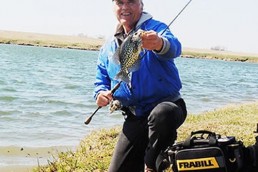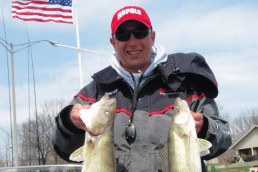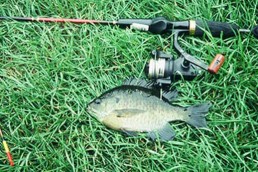Against the Wind
SHARE THIS POST
If the first thought that pops into your mind after reading the title is, “Cool Bob Seger tune!” then, like me, you probably have a few grey hairs under that fishing hat. Don’t worry, this isn’t an article traveling down some type of musical memory lane, but I have to admit I had to fire that song up on YouTube to get into the moment—oh wait, “Turn The Page,” another awesome tune, okay, back to fishing!
Wind. Residing in the Chicagoland area, wind is a weather factor that presents itself daily. Wind is an ever changing, often unpredictable happening, and at times can change from minute to minute, especially in this part of the Midwest. When fishing, wind can be a welcome factor on your outing, or, at other times, a pure nightmare. Either way, the wind is a force that will have to be dealt with.
Many anglers will shy away from the wind, often doing whatever necessary to find a stretch of bank unaffected by the wind. I certainly understand the annoyance when casting during windy conditions. Depending on seasonal temps for example, cold winds can basically ruin a day on the water, but winds can, and often do, have a positive influence on fishing, which will be the focus of this article.
Focusing on summer
I prefer to keep my articles seasonal, so the topic of the wind factor will be centered on this late summer season of peak water temps; we’ll hold off on the blustery winds of the late fall for another article.
August is normally the month when water temps here in the Midwest peak, and while this may be welcomed by many water activities, the bath-like water temps can have a negative influence on fish and angling for that matter. While the high water temps are often associated with somewhat of a slowdown in late summer fishing success, a much more critical circumstance can occur during this late summer season. Oxygen depletion becomes not only a threat to your fishing success, but actually becomes a health risk for fish, and in extreme cases, can cause a summer die-off.
We’re not going to delve deep into the oxygen tolerances for certain species or parts per million jargon for optimum levels for fish survival and behavior, but rather focus on the positive influence wind can have in naturally aerating your body of water and a few other conditions or situations the wind creates, that once explained, hopefully will help you think of wind as an asset to your fishing, rather than an annoyance to avoid.
Like I mentioned, I’m not going to dwell heavily the biological effects of oxygen on fish, but it is critical and often overlooked. Think about it—if you can’t breathe, how interested are you in consuming your next meal? No different for fish. Most fish can tolerate much higher water temps than you would think, but low or nonexistent oxygen levels, not so much. The fish will seek out optimum oxygen levels when necessary despite water temps.
Aerating water
Oxygen is created naturally under water by plants, but other circumstances assist in aerating most bodies of water, examples being, water flowing into a lake or pond, such as stream, rain run-off, storm sewer waters, as well as heavy rains, manmade structures such as aerators and fountains, and of course wind, natures very own aerator. Waves created by the wind aerate the surface water; the stronger the wind, the more oxygenation created for a particular body of water.
Beyond the oxygen influence of the wind, winds create some other favorable circumstances for the angler. Winds can push offshore plankton towards the bank angler. Along with the plankton comes the small fish feeding on that plankton, and right behind them, you got it, predator fish feeding on those smaller fish. These areas of plankton sometimes are well out of reach of the bank angler, but thanks to the wind, fish are being drawn to the water right in front of you.
In addition to plankton, winds will often force insects onto the water’s surface, creating another feeding opportunity for some species. Like plankton, these insects are at the mercy of the wind and only travel as far as the nearest windblown bank, right at your feet.
Undertow and things to look for
One other condition or effect created by the wind is undertow. Undertow is normally associated with large bodies of water such as the Great Lakes or the ocean, but it exists to a lesser extent on smaller bodies of water when winds and waves contact the shoreline, causing the water to not only splash up onto the bank, but also to roll back under the surface causing somewhat of an outgoing current back towards the depths. We’ll discuss the benefits of undertow in a moment.
Are you enjoying this post?
You can be among the first to get the latest info on where to go, what to use and how to use it!
While wind in my face is my first priority when heading out this time of year, I will search for areas on the windblown shoreline that possibly have a firmer shoreline composition, such as rocks, riprap, stone, or anything solid. A softer bank consisting of mud or sand actually absorbs the force of the waves and the turnaround water or undertow effect will be hindered or less pronounced.
Another factor in creating a strong undertow is water depth. The deeper the water near the windy shoreline, the more significant roll the waves will create, pushing water back out towards the depths.
So what’s the interest in undertow when it comes to angling success? Basically, it carries a variety of food options away from the shoreline, out to awaiting fish just off the bank, much the way current moves food in a river system. It’s like having a buffet table rolled up to your lawn chair! Similar to the plankton situation, smaller fish feed in the undertow on small offerings, followed by larger fish coming in to feed on the smaller fish. Sometimes injured or dead baitfish such as shad will be moved by winds across the surface towards these windswept banks, stacking up in the shallows or becoming part of the underwater current created by the undertow. No matter what the circumstance, undertow means food availability to fish, and they use it to their advantage.
So with the basics of why the wind is critical to success during these heated water conditions of late summer, next up for discussion will be baits and techniques to work these active areas.
Baits and strategies to consider
Since pretty much all species pursue the benefits of what the wind brings, we’ll hit on a few baits and techniques to hopefully help boost your success. Fish will often feed in close proximity to the shoreline under windy conditions, even during these warm water periods.
For most gamefish, I will throw rather fast-moving, high-vibration type baits. Shallow to mid-range crankbaits, geared towards the size of the species you are pursuing, are one of my first baits out of the bag. These are power baits and can cover a considerable amount of water.
In addition to the crankbait, spinnerbaits, chatter-type baits and plastic swimbaits have proved themselves worthy under these windy conditions; simply adjust your bait size to fit your species. Most of my baits for these windy waters are power-type baits, as finesse fishing is often difficult with onshore winds. It hinders both casting and bite detection. Besides, when these winds fire up, fish seem to be a little more active and not so much tight to cover, so power-style baits are the most effective in locating feeding fish.
Live bait on heavy bottom rigs can also work these windy areas as well, as many species will be working the bottom near the undertow. One tip under these high wind conditions is to keep your baits a little closer to the bank, depending on water depths. Fish are roaming these closer locations, so casting your bait across the lake is not necessary, and at times will actually put you off of active fish.
Floats and live bait work well in these windy conditions as well. Very buoyant floats will move quickly across the windy surface and at times, this drifting of the bait is a positive tactic. If you use a waggler-type float, where the line attaches at the bottom of the float, you can bury your rod tip underwater, keeping the float in place due the line being below the surface, not affected by the winds. This system works exceptionally well if you know the location of the fish.
With late summer fishing in full force, use the wind to your advantage instead of trying to avoid its presence. Wind and its effects can and often do have positive influence on the success of your outing, so keep casting against the wind.
MWO
SHARE THIS POST
Did you enjoy this post?
You can be among the first to get the latest info on where to go, what to use and how to use it!
Dan Brozowski
Passion for angling drives Dan Brozowski to the water’s edge virtually any chance he gets. Although passion cannot be measured, weighed, or recorded, it can be shared. He does this through his writing and while on the water. If you have any questions or comments for Dan, you may contact him at: onthebank@att.net.



